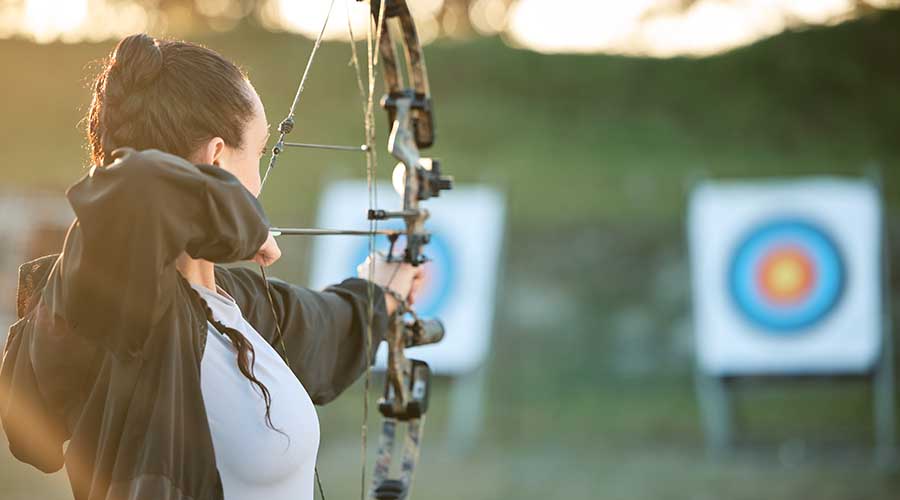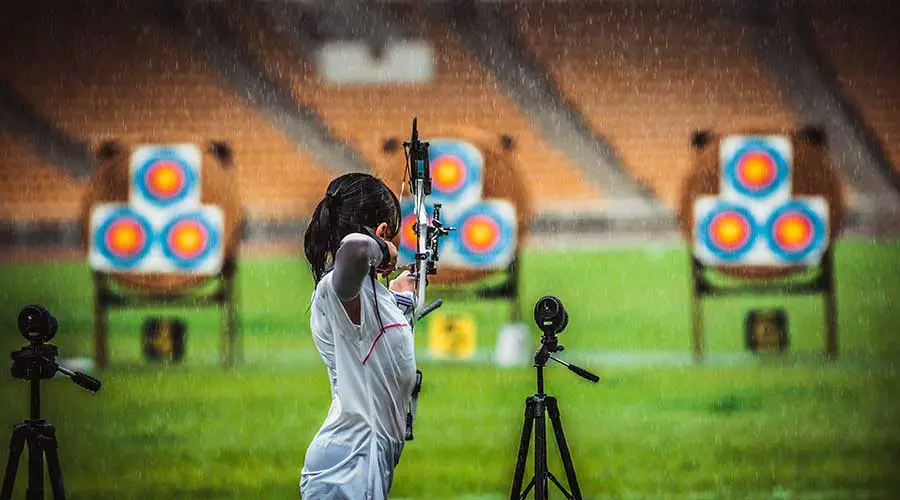Archery is a sport that consists of shooting arrows with a bow in order to hit a target.
This practice dates back to prehistoric times, when it was used for hunting and war, but also as a form of leisure and competition.
Over the centuries, archery has developed in different cultures, with variations in the types of bows, arrows and techniques.
In the 20th century it became an Olympic sport, with defined rules and categories. That’s exactly what we’re going to see next!
In this complete and up-to-date guide, you’ll learn a little more about the history, techniques and how the sport’s competitions work.
Check it out 👇
History of archery
Archery is an ancient practice that dates back to the dawn of mankind. Its origins are difficult to pinpoint, but there is evidence that it was used as a hunting and war tool by various ancient cultures around the world, from prehistoric times to the modern age.
Over time, the practice also became a form of entertainment and sporting competition. In England, during the 18th and 19th centuries, archery clubs sprang up where people could practise the sport recreationally.
At the end of the 19th century, archery was included in the 1900 Olympic Games in Paris, marking its debut as an Olympic discipline. Since then, it has undergone several changes in rules and regulations, as well as technological advances in the manufacture of bows and arrows.
Today, it is practised all over the world as a sport of precision, requiring concentration, skill and emotional control. The sport is a celebration of tradition and human evolution, keeping an ancient practice alive in a contemporary context.
How does archery work?

Archery competitions follow international standards set by World Archery, formerly known as FITA.
The championships have different formats, such as individual and team competitions. The rules, therefore, can vary according to each event.
The structure of the competitions includes the definition of distances, which can vary from 18 metres to 90 metres in outdoor competitions. In indoor events, the distances are generally shorter.
Archers aim at targets made up of coloured concentric rings, each assigning specific scores. These rings divide the target into zones, with the centre being the maximum scoring point.
Athletes have a predetermined number of arrows to shoot during each round of the competition. The total points are calculated based on the accuracy of the shots.
In addition, there are different competition categories, such as recurve and compound archery, each with its own specific characteristics.
During the competitions, archers face challenges that go beyond mere marksmanship. Concentration, emotional control and refined technique are essential aspects for success in the sport.
Archery categories
The main categories of the sport are the recurve bow and the compound bow. There are other disciplines, but they are not as popular as these two.
The recurve bow is the most traditional and widely practised style in the world. It is the category that features in the Olympic Games, for example.
Recurve bows have curved ends. This allows athletes to use accessories such as sights and stabilisers.
The compound bow, on the other hand, is characterised by pulleys, cables and pulleys, providing greater comfort and power when shooting.
Compound bow athletes generally use telescopic sights, which contribute to greater precision when shooting.
Archery categories at the Olympics
- Women’s individual;
- Men’s individual;
- Women’s team
- Men’s team;
- Mixed teams.
Archery equipment

The bow is the main piece of equipment in the sport. It can be recurve, compound or any other shape. Each type has its own peculiarities.
The arrow is another important element. They can be made of carbon, aluminium or synthetic materials, with feathers in different designs. The arrows are stored in quivers (a kind of pouch).
Archers can also attach accessories to their bows, such as sights and stabilisers. The aim is to increase shooting accuracy.
Finally, archers are allowed to wear arm and hand protectors, such as armbands, bracelets and finger pads. This helps protect them during competitions.
Archery rules
In the Olympics, archery is played in a duelling format. Each duel takes place between two athletes. In general, the archer who scores the most points is declared the winner. This is how they progress to the final.
The duel is divided into sets. In each set, each archer can shoot three arrows. At the end of each set, the scores are totalled. The athlete with the most points receives two set points. If there is a tie, each competitor gets one.
To win the match as a whole, you need to score six set points. Thus, the mechanics of the three-arrow sets are repeated until the score needed to clinch victory is reached.
In the Olympic Games, shots are made from a distance of 70 metres, but it’s worth remembering that this rule can be different depending on the championship.
Archery scoring system
A shot can be worth between 0 and 10 points. As the target is made up of rings, the further towards the centre the arrow is shot, the higher the score.
The rings are painted in specific colours, from largest to smallest: white, black, blue, red and yellow.
Arrows outside the target are worth 0 points, in the white circle between 1 and 2 points, in the black circle between 3 and 4 points, in the blue circle between 5 and 6 points, in the red circle between 7 and 8 points and in the yellow circle between 9 and 10 points. If the arrow hits the divider of two rings, the one with the higher score counts.
How is an archery shot made?

- Positioning | The archer stands sideways to the target, feet shoulder-width apart. The foot closest to the target points towards it, while the other foot is perpendicular;
- The archer holds the bow in the non-dominant hand, fully extending the arm. The pressure must be firm, but without tensing the hand too much;
- Finger position | The string hand holds the bowstring. The index, middle and ring fingers are usually used. Thus, the archer uses a consistent hook on the lower lip to ensure a consistent anchorage;
- Posture | The archer keeps the shoulders relaxed and the back straight, ensuring a stable posture. The rope is pulled by the movement of the shoulders and not just the arms;
- Sight | The archer aligns the sight (if using one) with the target, adjusting it to the correct distance;
- String pull | The archer begins to pull the string towards the face, maintaining a smooth and consistent movement. The pull is made mainly by the muscles of the back and shoulders, not the arms;
- Anchoring | The string is anchored to the chosen reference point, usually the chin or mouth. Consistent anchoring is crucial to ensure repeatability of the shot;
- Release | The archer releases the string in a controlled manner, allowing the energy stored in the bow to be transferred to the arrow.
Now you know all about archery and are ready to follow the thrilling duels at the Olympics! Did you like this content?Let us know in the comments! And come visit our website every day 😉



